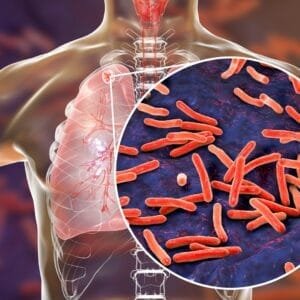Tuberculosis (TB): Causes, Symptoms, and Treatment
Tuberculosis (TB) is a highly contagious infectious disease caused by the bacterium Mycobacterium tuberculosis. It primarily affects the lungs (pulmonary TB) but can also impact other parts of the body, such as the kidneys, spine, and brain. Despite being preventable and curable, TB remains one of the top 10 causes of death worldwide, especially in developing countries. Early diagnosis and treatment are critical to controlling its spread.



What is Tuberculosis?
Tuberculosis is a bacterial infection that spreads through tiny droplets released into the air when an infected person coughs, sneezes, or speaks. While the immune system can often suppress the bacteria, they may remain dormant and cause active TB later in life, particularly when immunity is weakened.
There are two main forms of TB:
- Latent TB: The bacteria are inactive and cause no symptoms but may become active later.
- Active TB: The bacteria multiply and cause symptoms, which can spread to others.
Causes of Tuberculosis
TB is caused by the bacterium Mycobacterium tuberculosis, which spreads through airborne transmission. Risk factors include:
- Close Contact: Living or working closely with an infected person.
- Weakened Immune System: HIV/AIDS, diabetes, or chemotherapy increase susceptibility.
- Poor Living Conditions: Overcrowded or poorly ventilated spaces promote the spread.
- Travel to High-Risk Areas: Regions with high TB prevalence, such as sub-Saharan Africa or Southeast Asia.
- Malnutrition: Weakens the immune response to TB bacteria.
Symptoms of Tuberculosis
The symptoms of TB vary depending on whether it affects the lungs or other organs. Common symptoms include:
Pulmonary TB Symptoms:
- Persistent cough lasting three weeks or longer.
- Coughing up blood or sputum (mucus).
- Chest pain or discomfort.
- Shortness of breath.
General TB Symptoms:
- Fever and chills.
- Night sweats.
- Unexplained weight loss.
- Fatigue or weakness.
- Loss of appetite.
Extrapulmonary TB Symptoms:
TB affecting areas outside the lungs may cause back pain (spinal TB), blood in urine (kidney TB), or confusion (brain TB).
Diagnosis of Tuberculosis
Diagnosing TB involves a combination of physical examinations, laboratory tests, and imaging:
- Tuberculin Skin Test (TST): A small amount of TB protein is injected under the skin; swelling indicates exposure to TB.
- Interferon-Gamma Release Assays (IGRAs): Blood tests that detect TB bacteria.
- Sputum Tests: Microscopy and culture identify TB bacteria in mucus samples.
- Chest X-rays or CT Scans: Show lung damage or cavities caused by TB.
- Biopsy or Fluid Analysis: For extrapulmonary TB, samples from affected areas are tested.
Treatment Options for Tuberculosis
TB treatment requires a strict regimen of antibiotics over several months to ensure all bacteria are eradicated. The primary medications include:
Standard TB Treatment
- Isoniazid (INH): Kills actively multiplying bacteria.
- Rifampin (RIF): Stops bacterial RNA synthesis.
- Ethambutol (EMB): Prevents bacterial cell wall formation.
- Pyrazinamide (PZA): Targets dormant bacteria.
The treatment typically lasts 6-9 months and requires strict adherence to prevent drug resistance.
Multidrug-Resistant TB (MDR-TB)
- MDR-TB occurs when bacteria become resistant to standard TB drugs.
- Requires second-line drugs like fluoroquinolones or injectable medications.
- Treatment duration is longer (up to 2 years).
Supportive Care
- Adequate nutrition to strengthen the immune system.
- Treatment of coexisting conditions like HIV or diabetes.
Complications of Tuberculosis
If untreated, TB can lead to serious complications, including:
- Lung Damage: Permanent scarring or reduced lung function.
- Meningitis: TB bacteria in the brain cause swelling and neurological symptoms.
- Spinal Damage: TB of the spine (Pott’s disease) can lead to deformity or paralysis.
- Sepsis: A life-threatening response to infection spreading throughout the body.
Preventing Tuberculosis
Prevention strategies aim to reduce exposure and improve immunity:
- Vaccination: The BCG vaccine is effective in preventing severe TB in children.
- Infection Control: Use masks and improve ventilation in crowded areas.
- Treat Latent TB: Prevent active TB development in high-risk individuals.
- Healthy Lifestyle: Maintain a balanced diet and regular exercise to boost immunity.
FAQs about Tuberculosis
1. How does tuberculosis spread?
TB spreads through airborne droplets released when an infected person coughs, sneezes, or speaks.
2. What is the difference between latent and active TB?
Latent TB is non-contagious and symptomless, while active TB involves symptoms and can spread to others.
3. Can tuberculosis be cured?
Yes, TB is curable with a proper and complete course of antibiotics.
4. What are the signs of extrapulmonary TB?
Extrapulmonary TB may cause symptoms like back pain, swelling, confusion, or blood in the urine, depending on the affected area.
5. Is the BCG vaccine effective for adults?
The BCG vaccine is primarily effective in preventing severe TB in children and has limited efficacy in adults.
Conclusion
Tuberculosis remains a global health challenge but is both preventable and treatable with timely intervention. Understanding its causes, recognizing early symptoms, and adhering to treatment protocols can save lives and prevent the spread of this infectious disease. Public health measures like vaccination, improved living conditions, and early screening are vital to reducing TB’s burden worldwide.
